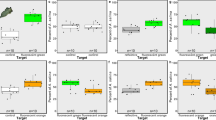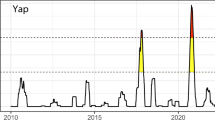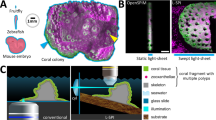Abstract
The discovery of yellow-green fluorescent bands in the skeletons of massive corals from inshore waters of the Great Barrier Reef, and the temporal and spatial correlations of these bands with adjacent river flow1, prompted an investigation into the substances responsible for the phenomenon. We have determined that all regions of the coral skeleton contain fulvic acids2,3 which impart a blue background fluorescence. The yellow-green fluorescent bands found only in inshore coral appear to result from enhanced concentrations of low-relative molecular mass (<10,000) fulvic acids from adjacent river input. These compounds are ubiquitous, and the yellow-green banding phenomenon can be expected to occur in massive corals located near to significant river systems. In the widely distributed genus Porites4, the great age of the largest colonies1 means that extremely long, highly resolvable records of coastal runoff exist throughout tropical nearshore seas.
This is a preview of subscription content, access via your institution
Access options
Subscribe to this journal
Receive 51 print issues and online access
$199.00 per year
only $3.90 per issue
Buy this article
- Purchase on Springer Link
- Instant access to full article PDF
Prices may be subject to local taxes which are calculated during checkout
Similar content being viewed by others
References
Isdale, P. Nature 310, 578–579 (1984).
Schnitzer, M. in Soil Organic Matter (eds Schnitzer, M. & Khan, S. U.) 1–64 (Elsevier, Amsterdam, 1978).
Willey, J. C. Mar. Chem. 15, 19–45 (1984).
Veron, J. E. N. & Pichon, M. Aust. Inst. mar. Sai. Monogr. Ser. V (1982).
Larson, R. A. & Rockwell, A. L. Arch. Hydrobiol. 89, 416–425 (1980).
Willey, J. D. & Atkinson, L. P. Estuar. Coast. Shelf Sci. 14, 49–59 (1982).
Stewart, A. J. & Wetzel, R. G. Limnol. Oceanogr. 25, 559–564 (1980).
Ghassemi, M. & Christman, R. F. Limnol. Oceanogr. 13, 583–597 (1968).
Stuermer, D. H. & Harvey, G. R. Deep Sea Res. 24, 303–309 (1977).
Cole, J. J., McDowell, W. H. & Likens, G. E. Oikos 42, 1–9 (1984).
Mueller, H. & Bandaranayake, W. Mar. Chem. 12, 59–68 (1983).
Hedges, J. I. & Parker, P. L. Geochim. cosmochim. Acta 40, 1019–1029 (1976).
Author information
Authors and Affiliations
Rights and permissions
About this article
Cite this article
Boto, K., Isdale, P. Fluorescent bands in massive corals result from terrestrial fulvic acid inputs to nearshore zone. Nature 315, 396–397 (1985). https://doi.org/10.1038/315396a0
Received:
Accepted:
Issue Date:
DOI: https://doi.org/10.1038/315396a0
This article is cited by
-
Increasing coral calcification in Orbicella faveolata and Pseudodiploria strigosa at Flower Garden Banks, Gulf of Mexico
Coral Reefs (2021)
-
Anthropogenic Anoxic History of the Tuvalu Atoll Recorded as Annual Black Bands in Coral
Scientific Reports (2020)
-
Sub-annual fluorescence measurements of coral skeleton: relationship between skeletal luminescence and terrestrial humic-like substances
Coral Reefs (2020)
-
Freshwater impacts in the central Great Barrier Reef: 1648–2011
Coral Reefs (2015)
Comments
By submitting a comment you agree to abide by our Terms and Community Guidelines. If you find something abusive or that does not comply with our terms or guidelines please flag it as inappropriate.



